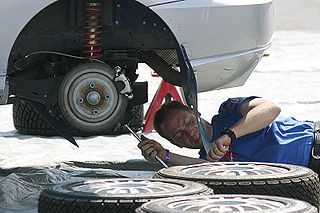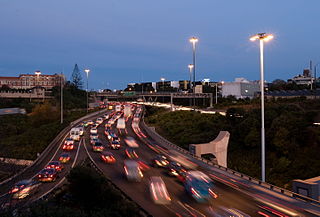
A tradesman, skilled tradesman, or tradie refers to a skilled worker who specializes in a particular occupation that requires work experience, on-the-job training, and often formal vocational education, but not a bachelor's degree.

The Hudson Motor Car Company made Hudson and other brand automobiles in Detroit, Michigan, U.S., from 1909 to 1954. In 1954, Hudson merged with Nash-Kelvinator to form American Motors Corporation (AMC). The Hudson name was continued through the 1957 model year, after which it was discontinued.

The Australian Manufacturing Workers Union (AMWU), or more fully the Automotive, Food, Metals, Engineering, Printing and Kindred Industries Union, is an Australian trade union. The AMWU represents a broad range of workers in the manufacturing sector, as well as associated industries, and is affiliated to the Australian Council of Trade Unions.
The Wayne Corporation was an American manufacturer of buses and other vehicles under the "Wayne" marque. The corporate headquarters were in Richmond, Indiana, in Wayne County, Indiana. During the middle 20th century, Wayne served as a leading producer of school buses in North America.

A knock-down kit is a collection of parts required to assemble a product. The parts are typically manufactured in one country or region, then exported to another country or region for final assembly.

A coachbuilder, or body-maker, manufactures bodies for passenger-carrying vehicles. Coachwork is the body of an automobile, bus, horse-drawn carriage, or railroad passenger car. The word "coach" was derived from the Hungarian town of Kocs.

Automotive design is the process of developing the appearance, and to some extent the ergonomics, of motor vehicles, including automobiles, motorcycles, trucks, buses, coaches, and vans.

The Australian Rail Tram and Bus Industry Union (RTBU) is a powerful Australian trade union representing rail, tram and bus workers. The RTBU is affiliated with the Australian Council of Trade Unions (ACTU) and the Australian Labor Party (ALP).

An auto mechanic is a mechanic with a variety of automobile makes or either in a specific area or in a specific make of automobile. In repairing cars, their main role is to diagnose the problem accurately and quickly. They often have to quote prices for their customers before commencing work or after partial disassembly for inspection. Their job may involve the repair of a specific part or the replacement of one or more parts as assemblies.

The National Union of Vehicle Builders (NUVB) was a trade union in the United Kingdom. The NUVB represented a mixture of skilled and unskilled workers in the automotive industry.

A substantial car industry was created in Australia in the 20th century through the opening of Australian plants by international manufacturers. The first major carmaker was Ford Australia and the first Australian-designed mass production car was manufactured by Holden in 1948. Australian manufacture of cars rose to a maximum of almost half a million in the 1970s and still exceeded 400,000 in 2004. Australia was best known for the design and production of 'large' sized passenger vehicles. By 2009 total production had fallen to around 175,000 and the Australian market was dominated by cars imported from Asia and Europe.

The Federated Miscellaneous Workers' Union (F.M.W.U.), commonly known as the 'Missos', was an Australian trade union which existed between 1915 and 1992. It represented an extremely diverse and disparate range of occupations, but its core support came from workers employed in cleaning and security services.
This article provides an overview of the automotive industry in countries around the world.

The automotive industry in New Zealand supplies a market which has always had one of the world's highest car ownership ratios. The distributors of new cars are essentially the former owners of the assembly businesses. At the dealership level they have maintained their old retail chains in spite of the establishment of the many new independent businesses built since the 1980s by specialists in used imports from Japan. Toyota entered into direct competition with those used-import businesses refurbishing old Toyotas from Japan and selling them through their own dealers as a special line. The nation's car fleet is accordingly somewhat older than in most developed countries.

The Federated Ironworkers' Association of Australia (FIA) was an Australian trade union which existed between 1911 and 1991. It represented labourers and semi-skilled workers employed in the steel industry and ironworking, and later also the chemical industry.
The Printing and Kindred Industries Union (PKIU) was an Australian trade union which existed between 1966 and 1995. It represented production workers in the printing industry, including compositing, typesetting, letterpress printing, lithographic plate-making, electrotyping, stereotyping and bookbinding, and the manufacture of paper and cardboard products, such as paper bags, envelopes, cardboard boxes and cartons. Approximately half of all members were qualified tradespeople, with the remainder semi-skilled or unskilled workers.
The Federated Moulders' (Metals) Union of Australia (FMMUA) was an Australian trade union which existed between 1899 and 1983. It represented moulders - skilled tradesmen who fabricated the moulds used to cast metal products in foundries. In spite of the union's exclusive attitude towards membership, which kept the total number of FMMUA members low throughout its existence, the vital position of moulders in major industries such as mining, manufacturing and the railways ensured that the union remained industrially powerful, and the union had a reputation for being highly militant.
South Africa is traditionally the leader in Africa of the automotive industry and now produces more than half a million automobiles annually of all types. While domestic development of trucks and military vehicles exists, cars built under license of foreign brands are the mainstay.

Duncan & Fraser Limited was a vehicle manufacturing company founded in 1865 in Adelaide, South Australia that built horse-drawn carriages and horse trams, and subsequently bodies for trains, electric trams and motor cars, becoming one of the largest carriage building companies in Australia.














